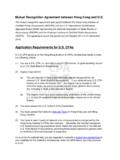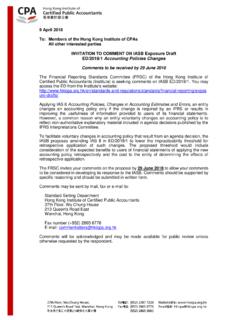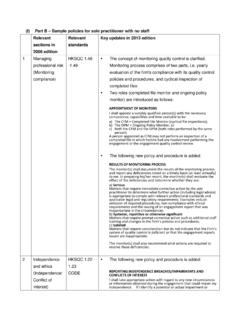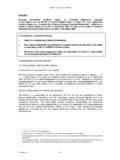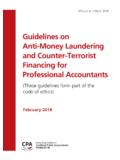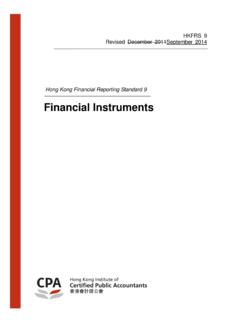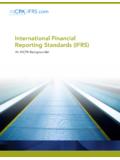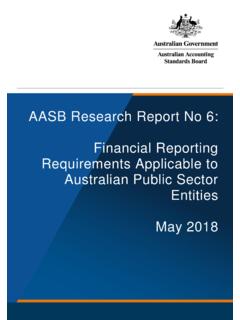Transcription of The Questions and Answers (Q&As) below were …
1 The Questions and Answers (Q&As) below were developed by the financial reporting standards Committee ("FRSC") of the hong kong Institute of Certified Public Accountants (the HKICPA) and are for general reference only. The HKICPA, FRSC and their staff do not accept any responsibility or liability in respect of the Q&As and any consequences that may arise from any person acting or refraining from action as a result of any materials in the Q&As. Members of the HKICPA and other users of these Q&As should also read the original text of HKAS 12 Income Taxes, as found in the HKICPA Members'.
2 Handbook ( ) for further reference and seek professional advice where necessary when applying the guidance contained in these Q&As. The HKICPA's Standard Setting Department welcomes your comments and feedback on this paper, which should be sent to Substantively enacted Question 1: In hong kong , at which point in time are tax rates 'substantively enacted' for the purposes of HKAS 12 Income Taxes ? Paragraph 46 of HKAS 12 states that "Current tax liabilities (assets) for the current and prior periods shall be measured at the amount expected to be paid to (recovered from) the taxation authorities, using the tax rates (and tax laws) that have been enacted or substantively enacted by the end of the reporting period.
3 ". Paragraph 47 of HKAS 12 states that "Deferred tax assets and liabilities shall be measured at the tax rates that are expected to apply to the period when the asset is realised or the liability is settled, based on tax rates (and tax laws) that have been enacted or substantively enacted by the end of the reporting period.". Paragraph 48 of HKAS 12 states that "Current and deferred tax assets and liabilities are usually measured using the tax rates (and tax laws) that have been enacted. However, in some jurisdictions, announcements of tax rates (and tax laws) by the government have the substantive effect of actual enactment, which may follow the announcement by a period of several months.
4 In these circumstances, tax assets and liabilities are measured using the announced tax rate (and tax laws).". Answer: According to the Basic Law of the hong kong Special Administrative Region ("HKSAR"), after a bill has been gazetted, it has to pass through three readings in the Legislative Council ("LegCo") before it is enacted. A bill is subject to debate and vote in the Second and Third Readings. If a bill is rejected during either of those Readings, no further proceedings shall be taken on it. A bill passed by LegCo after the Third Reading shall take effect only after it is signed and promulgated by the Chief Executive.
5 Article 49 of the Basic Law states that "If the Chief Executive of the hong kong Special Administrative Region considers that a bill passed by the Legislative Council is not compatible with the overall interests of the Region, he or she may return it to the Legislative Council within three months for reconsideration. If the Legislative Council passes the original bill again by not less than a two-thirds majority of all the members, the Chief Executive must sign and promulgate it within one month, or act in accordance with the provisions of Article 50 of this Law.
6 ". Page 1 of 5. Article 50 of the Basic Law states that "If the Chief Executive of the hong kong Special Administrative Region refuses to sign a bill passed the second time by the Legislative Council, or the Legislative Council refuses to pass a budget or any other important bill introduced by the government, and if consensus still cannot be reached after consultations, the Chief Executive may dissolve the Legislative Council.". Article 52 of the Basic Law states that "The Chief Executive of the hong kong Special Administrative Region must resign under any of the following circumstances: (1).
7 When he or she loses the ability to discharge his or her duties as a result of serious illness or other reasons; (2) When, after the Legislative Council is dissolved because he or she twice refuses to sign a bill passed by it, the new Legislative Council again passes by a two-thirds majority of all the members the original bill in dispute, but he or she still refuses to sign it; and (3) When, after the Legislative Council is dissolved because it refuses to pass a budget or any other important bill, the new Legislative Council still refuses to pass the original bill in dispute.
8 ". Following the hong kong legislative process, a bill or law in hong kong is enacted only when it has been signed and promulgated by the Chief Executive. To our knowledge, there is no history of a Chief Executive returning bills passed by LegCo ( after Third Reading) for reconsideration since the establishment of the HKSAR. For the purpose of accounting for income taxes, the financial reporting standards Committee (FRSC) of the HKICPA considers a bill to be substantively enacted after passing the Third Reading ("substantive enactment date").
9 This is because the legislative procedures after the Third Reading appear to be a formality, and based on all the facts available to date, the FRSC considers there is usually reasonable certainty that a bill will be passed in law after the Third Reading. Should new information come to light, the FRSC will reassess the point in time of 'substantive enactment'. Question 2: In general, what is the accounting impact on financial statements with accounting periods that end before, on or after the substantive enactment date of the revised tax rates?
10 Answer: Current and deferred tax assets and liabilities should be measured at the tax rates that have been enacted or substantively enacted at the end of the reporting period. Current tax assets and liabilities are measured at the tax rate applicable in the year of tax assessment period, while deferred tax assets and liabilities are measured at the tax rates that are expected to apply to the period when the corresponding temporary differences are expected to reverse (paragraphs 46 and 47 of HKAS 12). financial statements with accounting periods that end before, but are authorised for issue after, the substantive enactment date should disclose the nature and an estimate of the financial effect of those changes if the impact is expected to be significant; or a statement that such estimate cannot be made (paragraph 21 of HKAS.)


